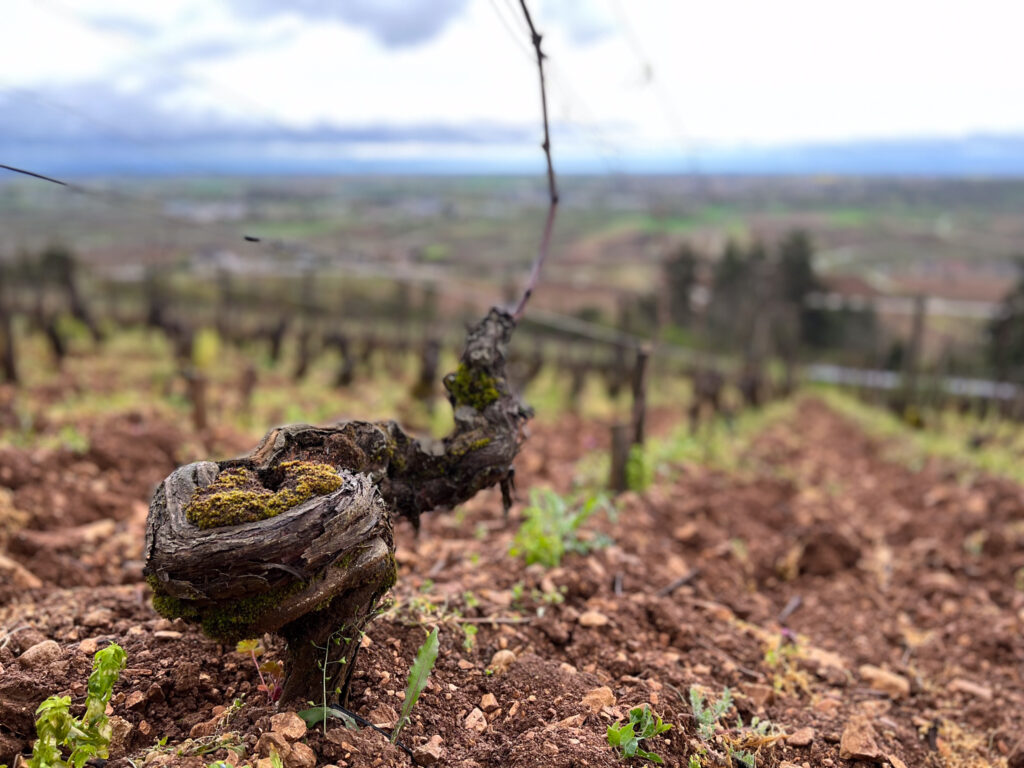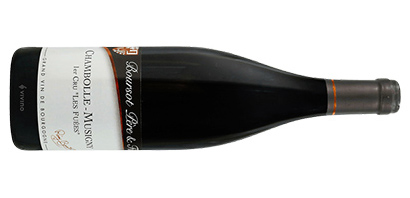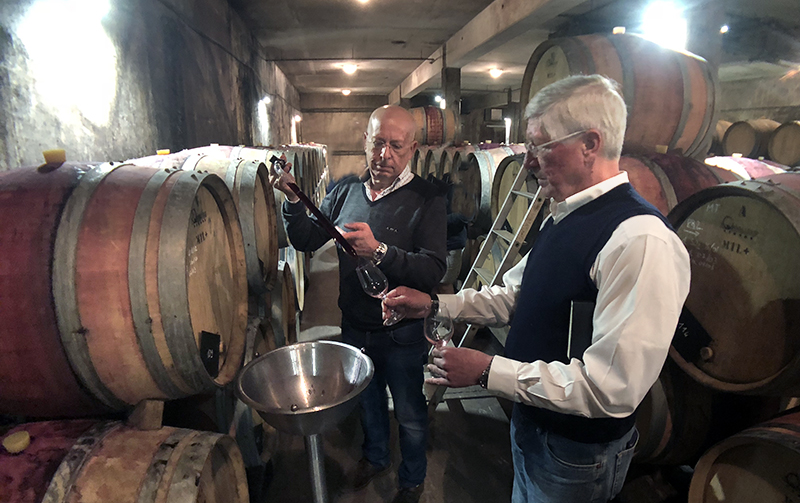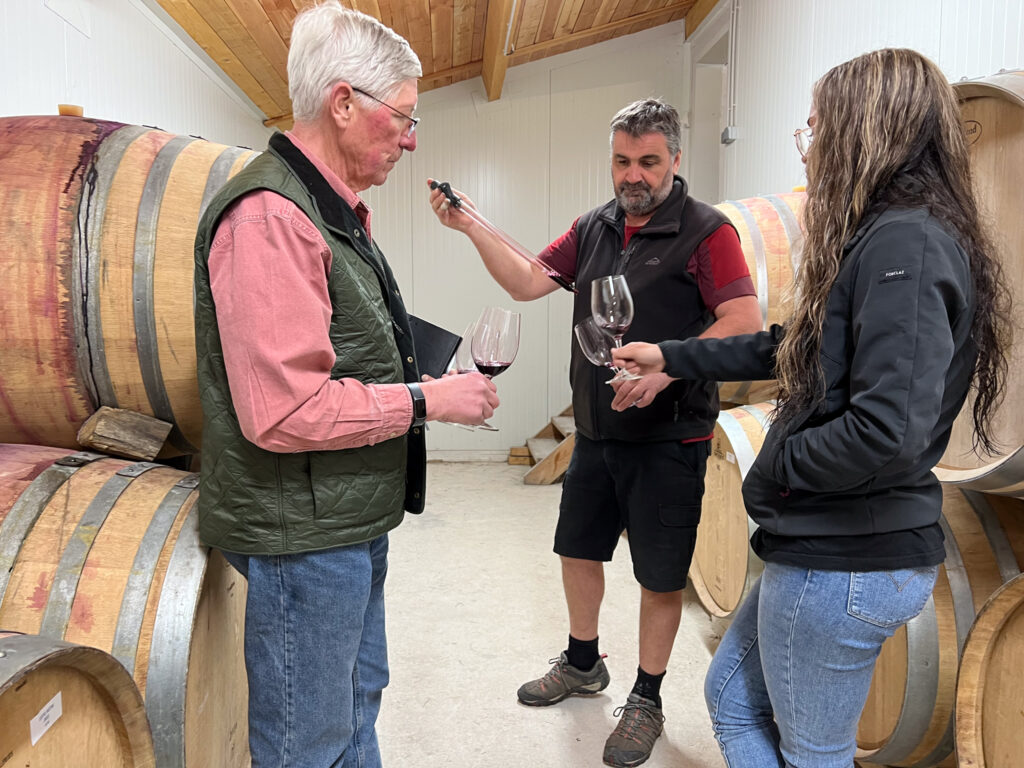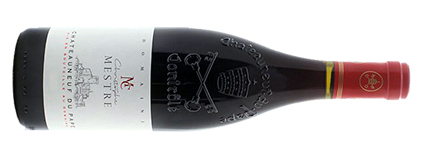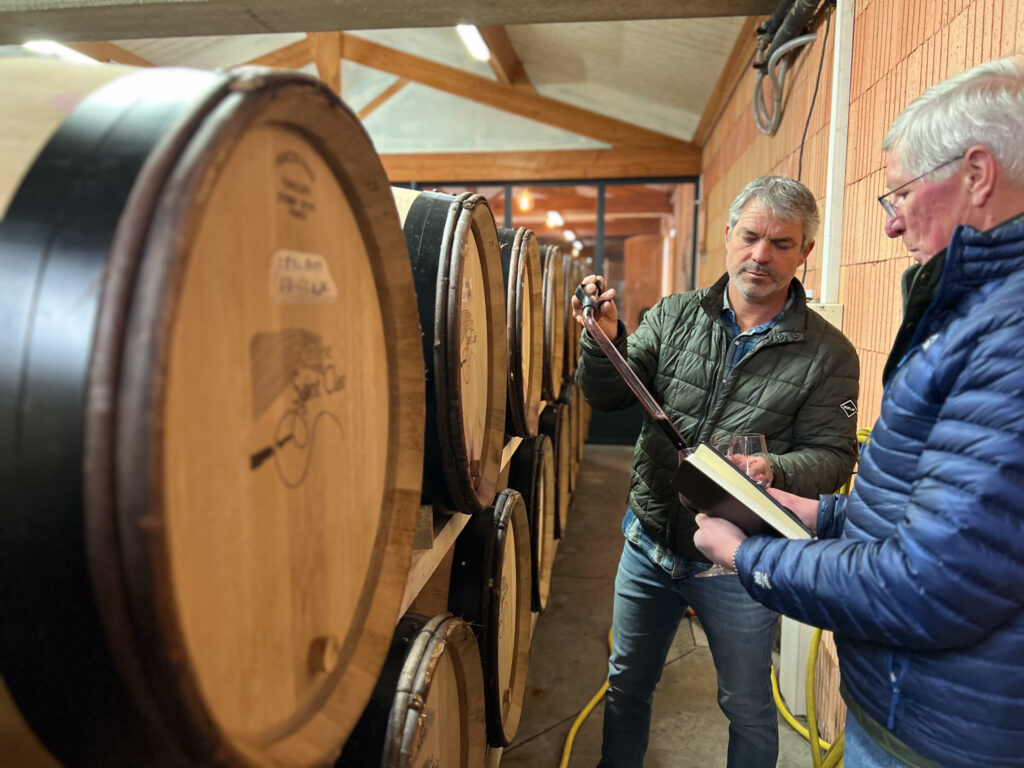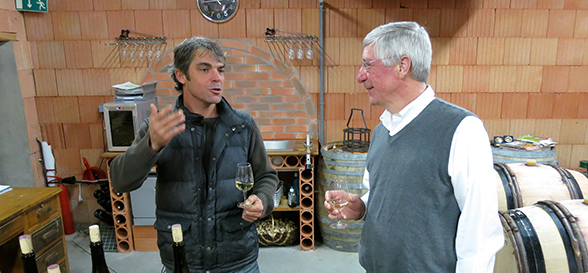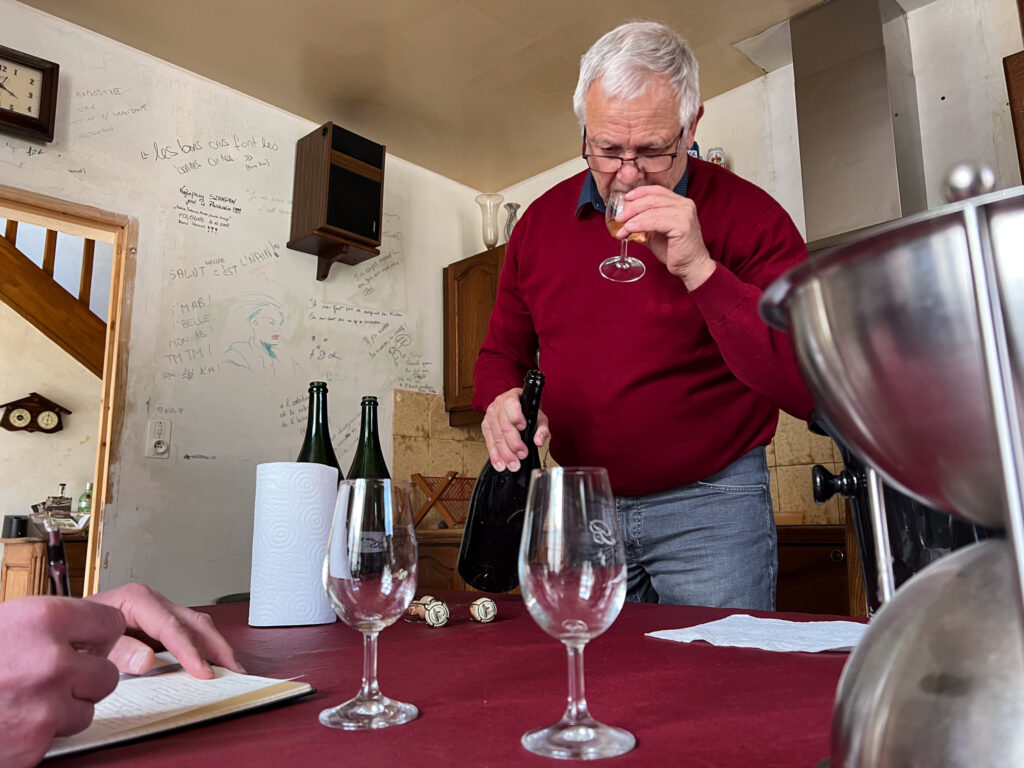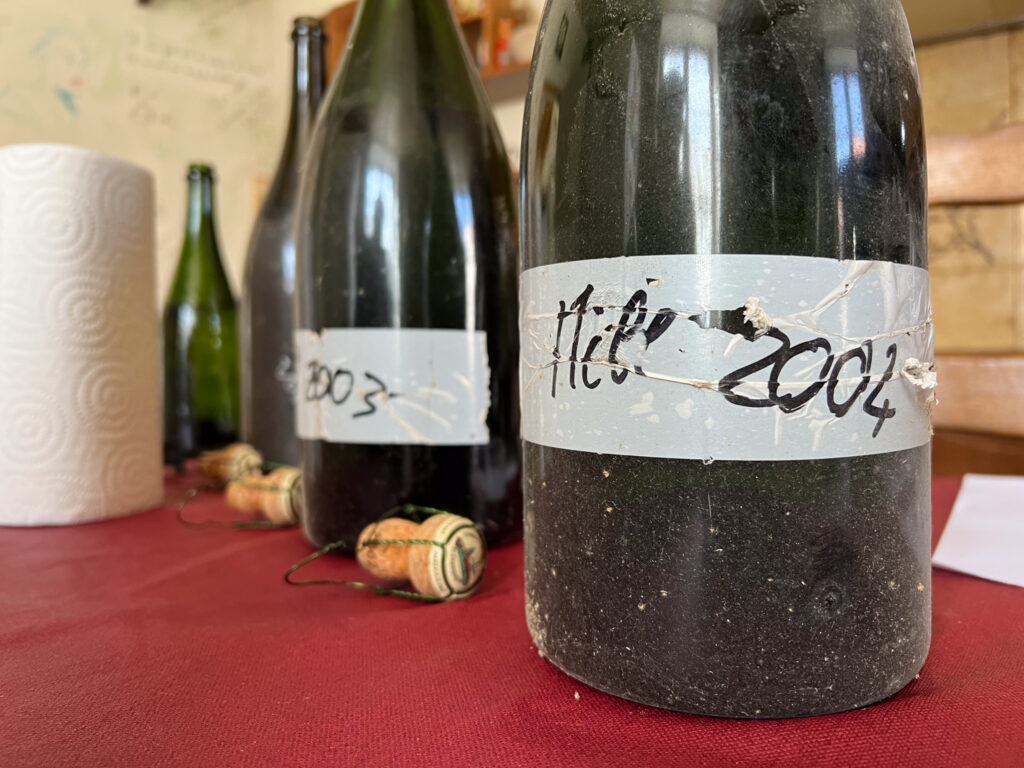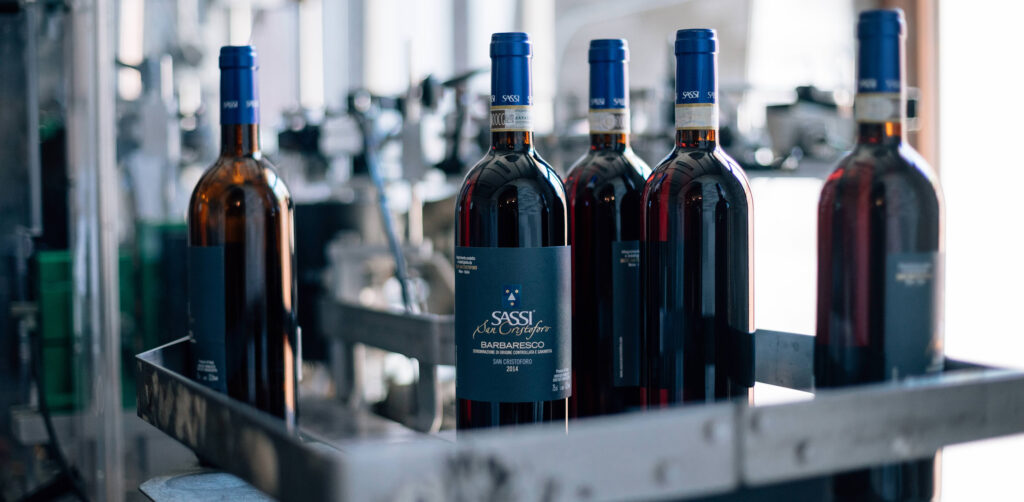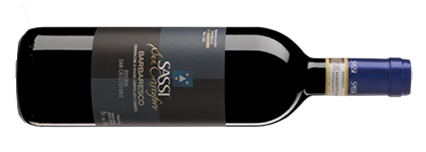As we complete this offering the harvest is in full swing in across France. It’s an all-hands operation, in which office staff, cellar staff, family and various hangers-on are drafted into service for the great annual endeavor. Ansonia père and fils have each been among the hangers-on, participating in the Côte d’Or harvest in 2017 and 2013, respectively. It really is something to behold, as pickers – some with decades of consecutive annual participation – come together for work, shared meals, and good cheer. The air is filled with the scents of yeast and the sounds of laughter. And despite advances in meteorology, plant and soil sciences in recent decades, it remains a guessing game. Harvest dates need to be set before all the relevant information is in hand, and when the weather is capricious (as it has been in recent days), the harvest is start and stop, with extra sorting and added early or late work. At the end of it all, each vintage acquires a distinct character, which is after all what makes this business so interesting. As usual, September Futures includes Burgundy in both colors, from the Côte de Beaune, the Côte de Nuits, and the Maconnais. There’s also Champagne, reds from both the Southern and Northern Rhône, and another visit to Piedmont. Our goal is always to propose wines for every taste and budget, and we hope you’ll find something of interest here. If you do, please be sure to submit your orders, in case or half-case lots, by the Order Deadline of Sunday, October 1, 2023. We will place orders for the wine immediately thereafter. JUMP TO SECTION
Boursot
Belland
Forces Telluriques
Bonnefond
Mestre
Saint-Clair
Bardoux
Sassi
September Futures
Order Deadline: 10/1
Domaine Boursot
Chambolle-Musigny, Burgundy
The Boursot family has grown grapes in Chambolle-Musigny since 1550. With a viticultural history older than most countries, the Boursots know their terroir inside and out. But it was only a generation ago that they began estate bottling, having previously sold their grapes to local caves, as was Burgundian custom. Even in the few short years that we’ve worked with them we’ve seen dramatic improvements at this domaine. The current generation, brothers Romaric and Romault Boursot, have gotten their winemaking legs firmly under them, and are now firing on all cylinders. We see tremendous upside potential at this domaine – a priceless collection of terroir combined with youthful energy, serious investment, and steadily improving winemaking. Jasper Morris MW writes that “the winemaking has been sharpened up by the current generation;” Neal Martin of Vinous finds the wines “superb” and writes of “a promising future.” We were quite taken with Boursot’s 2021s – an extremely difficult vintage that proved a test for even seasoned winemakers. The Boursot brothers passed with flying colors, and their humble Bourgogne rouge 2021 is a great place to start. Raised entirely in steel, this is gorgeous, accessible, simply delicious red Burgundy. The nose shows cherry, plum and white flowers; the mouth is fresh and chalky with raspberry notes and low tannin. The dry, classy finish ties it up into a neat package. An exceptional value under $30. For a slight upgrade, consider their Côte de Nuits-Villages, a richer wine from a supremely well-located plot of vines on the Route Nationale next to the Nuits-St-Georges 1er cru “Clos de la Marechale.” The 2021 is like the Bourgogne but with an added shot of density and structure. The freshness of the vintage carries through the dark plum fruit, but this one will need six months or so before it’s ready to drink. We expect great things around Summer 2024. We don’t import a lot of Savigny-les-Beaune, an out-of-the way appellation northwest of the city of Beaune. But Boursot’s red from Savigny has caught our eye two years in a row now, and we recommend it heartily. It’s lighter weight than their Chambolle, but with beautiful freshness and low tannin. The nose shows roses petals and apple; the mouth is vibrant and lithe with a lovely chalky minerality. For those in search of an accessible, middle-weight Pinot Noir of elegance and understatement, here’s your wine. Boursot’s hometown Chambolle-Musigny cuvées are truly delicious this year. The 2021 Chambolle village saw 25% new oak, and the rest in old barrels and amphora – a combination designed to bring out fruit and keep the wine fresh. This formula has worked beautifully, as the oak is nearly undetectable and the mouth is smooth and gourmand. Given the concentration and pH levels the 2021s should age with ease, but we expect this will be hard to put down when it arrives. Look for cassis, violet, and Chambolle’s signature silky mineral texture. Boursot’s finest wine comes from 75+ year old vines in the famous “Les Fuées” premier cru vineyard that borders the Grand Cru Bonnes Mares. Boursot’s Chambolle 1er 2021 Fuées is large and impressive – even in a cooler vintage it needs several years to integrate and come into itself. But all of the elements are there for a truly delicious wine: tannin, fruit, concentration, acidity, length, and that signature Chambolle charm. If you’ve got room in the back of the cellar, this will handsomely reward patience.
Domaine Roger Belland
Santenay, Burgundy
The 2021 growing season produced a lot of sleepless nights for vignerons in Burgundy, particularly those in the Côte de Beaune. Chardonnay dominates the Côte de Beaune, and its buds push sooner than those of Pinot Noir, making it more susceptible to early Spring frosts. The 2021 frost disaster was at its worst in the Côte de Beaune, dropping average yields in white wine to among the lowest we have seen. This cloud has a silver lining. While the amount of white Burgundy available is truly tiny, the quality can be excellent, and at the Domaine Roger Belland we found two whites that we think are superb. First, the Chassagne-Montrachet 1er cru “Morgeot” from the family’s monopole, the Clos Pitois. The 2021 is a lovely blend of fruit and oak. It is generous and ample in the mouth but supported by plenty of acidity, “enough to carry it for ten years,” according to cellar manager Martin Boyer. Burghound (Allen Meadows) was impressed as well. He found that “‘a beautifully layered nose offers up its combination of white orchard, fruit, resin, petrol and ripe citrus.” Meadows went on to praise its “impressive concentration” and its “balanced finale.” This is classic, regal Chassagne-Montrachet with focus and perfect balance. Our other choice in white is Belland’s Puligny-Montrachet 1er cru “Champs Gain” 2021. Typically for Puligny, it is a precise wine, refreshing and structured despite its excellent concentration. Burghound found that “cooler and more elegant aromas are comprised [of] notes of acacia blossom, mineral reduction, petrol and a whiff of white peach.” He thought the wine “wrapped in a seductive yet quite punchy finish where the supporting acidity reflects a touch of citrus.” All the elements – oak, fruit, acidity, minerals – are perfectly layered and integrated. Burghound predicted both these white wines would develop well with a few years of cellaring, and we heartily agree. In red we found one wine particularly compelling: The Volnay 1er cru “Santenots” 2021, vinified with 80% whole clusters. Burghound commented: “The high percentage of whole clusters is evident as the nose is the most floral-inflected of all of these wines while offering pretty aromas of red and dark berries, exotic tea and a suggestion of sandalwood.” He was impressed with its “really lovely texture” and its “balanced and persistent finale.” Like Burghound, we expect this wine to develop beautifully in the coming years. Even at this early stage it offers an impressive ripe nose of dark fruit. Our allocation for all three of these wines is very small, so those interested should send in their orders for them promptly.
Forces-Telluriques
Viré-Clessé, Burgundy
Many of you have already heard about the wonderful winemaking by our friends in the hamlet of Quintaine in the Maconnais, whom we discovered a quarter-century ago during our sabbatical year in the region. For years after our return from France we bought from them as private buyers, but began only recently to import their wine for sale by Ansonia Wines under a private label: “Forces Telluriques.” Burgundy’s top critics sing their praises, among them William Kelley (“These are honeyed, concentrated wines that are imbued with remarkable concentration and energy and develop beautifully in the cellar”), and Anthony Hanson, who reported in his book “Burgundy” that their wine “took my breath away.” They remind us a bit of Jacqueline André of Chateauneuf du Pape: organic and biodynamic for decades, and as committed to their vines as parents are to their children. When early frosts threaten, they have been known to prepare and spray herbal extracts that are taken up through the vines’ roots. We were mildly skeptical to hear about this when we arrived to visit on April 1 of 2022, amid an ongoing snowfall of more than an inch; but the vines came through the event with remarkably little damage to the buds. The Forces Telluriques 2021 is a worthy successor to the gorgeous 2020, which is disappearing from our personal cellars at a great rate. It has a lovely ripe nose, with a lovely, faint whisper of botrytis, a note often found in traditional Maconnais whites. The domaine harvested slowly, over about 15 days, and while many neighbors needed to chaptalize to achieve sufficient alcohol, their wine achieved levels between 13% and 13.5% naturally. The result is striking: in the 2021 there is ripeness without weight, a wine that is lively and alive. We cellared our last bottle of their great 1996 vintage until it was 25 years old, and found that it hadn’t lost a step when we pulled the cork a few years ago. We think this wine might well manage the same trick. Nor do these vignerons rest on their laurels. Five years ago they began to make a new cuvée from a patch of 65 year-old vines planted in clay soil. The wine is aged in clay amphoras for 15 months, and the result is remarkable wine: more concentrated and dense than the regular cuvée, yet exceedingly pure and alive, with a touch of grape-derived tannin akin to dried apricots. As we tasted the 2021 vintage of this Forces Telluriques Amphora during our visit last April, Gautier the winemaker waxed poetic about the psychic harmony achieved from using clay amphora to age the fruits from a clay-rich plot of vines – “a return to the earth” he called it. Both Ansonia père and fils each struggled to make adequately descriptive notes – so complete and alive is the wine that it somewhat defies description. At last père gave up and simply wrote “just beautiful,” then stole a glance at fils, who whispered “witchcraft.” Rather than figure out a second private label for the new cuvée, they’ll show the difference in wax. As with the 2018 and 2020, the regular cuvée will come with a gray wax cap; the one from amphoras will be orange.
Patrick & Christophe Bonnefond
Côte Rôtie, Northern Rhône
Most wine experts name three appellations of the Northern Rhône as the place where the world’s greatest expression of the Syrah grape is to be found: Hermitage, Côte Rotie, and Cornas. Of the three, Côte Rotie’s “roasted slope” produces wines of the most finesse and elegance rather than power. It is a dramatic sight: Côte Rôtie’s vines are found on a slope along the Rhône so steep that the vines cannot be worked with tractors. All the vineyard work is by hand, and the grapes are all Syrah. We have been buying Côte Rôtie for more than two decades at the Domaine Patrick & Christophe Bonnefond, and we have watched winemaker Christophe Bonnefond’s style evolve to a search for elegance above all else. In each vintage he seems to coax the best from his vines, and 2021 is the same. The domaine’s regular Côte Rôtie cuvée is “Colline de Couzou.” In 2021 it spent 15 months in elevage rather than the usual 18, and this made for a friendly, pretty wine that is both dry and subtle. The style reminds us of the 2017 red Burgundies: accessible, delicious wines that are drinking beautifully today. Not every great wine requires patience, and while this should go five years without issue, we expect it to be unusually delightful young The domaine’s other Côte Rôtie cuvées will pay more keeping. Their Côte Rozier plot is on a southeast facing plot bordering La Landonne. The 2021 is terrific, with the exquisite floral nose this always shows. In the mouth there is much depth, its dark, peppery fruit enhanced by just the right amount of oak. The wine simultaneously hits soaring high note aromatics, and deep, impressive, low-note palate concentration. In two or three years these elements will fuse together and the result will be striking. “Les Rochins” 2021 is from a plot with older vines (some pushing 70) and a more southerly exposition that receives more sun. The result is a denser wine, with exceptionally fine-grained tannins and very intense dark fruit. It may require a bit more time to round out and integrate, but the payoff will be a refined wine of exceptional elegance. To Christophe’s evident pleasure, his daughter Lea has joined him at the Domaine, and her own cuvée, Dans Les Vignes de Mon Père (“In My Father’s Vines”), comes from vines in both Rozier and Rochins. It is deeply colored, of exceptional intensity, and despite the addition of 6% Viognier (long permitted by the rules of the appellation), it is a wine of much power. The cuvée has met with much critical acclaim, garnering top scores. Our Burgundy analogy for this wine is to the big-shouldered wines of Gevrey-Chambertin, perhaps one of its many Grand Crus. The other gem of the Northern Rhône neighborhood that is home to Côte Rôtie is Condrieu, a white wine from 100% viognier. The grape can be found in many places around the world these days, but no other expression even remotely rivals Condrieu. The particular virtue of this wine is its astounding aromatics. Best served in a large balloon glass or a snifter, the expressive nose features tropical fruit like pineapple and orchard fruits like apricots and white peaches. Unlike most expensive wines, Condrieu is not meant for laying down. It is at its beautiful best in the few years after it is bottled. Finally, if you don’t have the budget for Côte Rotie or Condrieu, you can still enjoy the benefits of the Bonnefonds’ winemaking skill. From Syrah vines grown in less daunting terroir near the winery, they make a Syrah “Sensation du Nord” in the appellation IGP Collines Rhodaniennes. The wine is always well made and reasonably priced, and the Syrah 2022 delivers again. It features dark fruit with hints of pepper and dark chocolate, along with good freshness in the mouth. It will be a versatile wine for all sorts of everyday pleasures, from grilled sausages to kebabs to ratatouille. The 2022 in particular is a seriously impressive sub-$20 bottle.
Domaine Mestre
Châteauneuf-du-Pape, Southern Rhône
Christophe Mestre’s Chateauneuf du Pape offers one of the best values in the appellation. Like many old families of the village, his parcels range across the appellation, including some grown among the famous galets roulés, the round stones that cover the surface and reflect the day’s heat after sunset, and some in the sandy soils that will support vines of great age. We always enjoy our tastings there, since they offer a choice among a number of vintages. Our pick this year is the 2020 vintage, which will provide good drinking both this winter and for many years to come. When we tasted it in March, its elements had come together nicely, resulting in a wine with less alcohol and more finesse than the powerful 2019 and 2018. The nose is lovely: complex, sophisticated, and expressive. In the mouth it is beautifully layered, with good persistence on the finish. In short, a classic Chateauneuf that can effortlessly add warmth to a fall or winter’s evening. This will age several years if needed – particularly from magnum – but as with all of Mestre’s wines it requires no patience and will drink well from its arrival this November.
Domaine Saint-Clair
Crozes-Hermitage, Northern Rhône
It takes a healthy dose of resilience to be a vigneron these days. Severe spring frosts and scorching hot summers have upended the normal rhythm of winemaking to make an already inconsistent profession even less predictable. And yet most of our winemakers are as sanguine and upbeat as a loyal sports fan with a slumping team: “there’s always next year…” In the first week of April 2021 temperatures plunged from Champagne down to the Mediterranean – a mild winter and warm spring had pushed buds out on vines all over France, and the frost damage was widespread and catastrophic. Denis Basset told us his vines in Crozes-Hermitage were hit hard, and before the summer began he wasn’t certain there’d be a harvest at all. But the rest of the season proved so wet and mild that the vines whose buds survived the frost went into overdrive. “My neighbors whose vines weren’t frosted ended up with yields of 80 hectolitres / hectare,” he told us, (45 is the maximum allowed in the appellation, Basset is usually in the 30s). “Thank goodness for that frost,” he chuckled wryly. Along with the gift of unflinching optimism, Basset also happens to have a gift for winemaking. His 2021s are terrific – midweight, fresh, accessible, and full of energy and life (like their author). We’re suggesting three reds this year, along with a white from 2022. That through Futures pricing all four come in below $25 (and three below $20) always makes us check our math – these are remarkable values for the intensity and completeness of the wine. His first Crozes-Hermitage called “Etincelle” is something you’d find in a Parisian wine bar – simple, unoaked, well-made and lively. The nose is beautiful with violets and spices and black pepper. The mouth texture is croquant (crackling), with beautiful tension and a crisp, clean finish. Denis called it a “vin de soif” (wine for thirst) and we agree – pick up some of this now and when spring rolls around you’ll be ready for patio season early. Saint-Clair’s second Crozes cuvée is called “Fleur Enchantée.” Made from older vines and raised in some oak, this is far more intense and complex. The nose shows licorice, coffee, and stewed plums – in fact it’s hard to stop smelling this wine in the glass. The mouth is classy and sleek with powdery tannins and a dollop of sweet toast from the elevage. As readers with this wine in their cellar can attest, it both ages beautifully and drinks well young with the help of a decanter and a flavorful meat. Finally, across the river in St-Joseph Basset owns a tiny plot of vines on a steep slate plot – “ce n’est qu’un jardin” he tells us. This wine requires time in the bottle, but rewards it beautifully. It’s sleeker and more sophisticated than the Crozes cuvées, trading a rugged fullness for a bit of subtlety. The 2021 is beautiful but even more than usual will need some years to straighten out – very fine tannins and perfectly ripe inky fruit combined with a healthy dose of oak. Pull this out in five years and we predict it will be almost Burgundian in its elegance. Basset’s white is from 2022, a Crozes-Hermitage blanc that’s 95% Marsanne this year. The summer was so hot that his Roussanne grapes (usually a fifth of the blend) were sunburnt and had to be discarded. The remaining wine is impressive stuff – more concentrated than usual, with the classic exotic notes of melon, white plum, and nectarine. The mouth is dense and tightly wound with a dash of acidity amid the crashing wave of ripe fruit – Denis blocked the malolactic fermentation to retain freshness. This cuvée has something of a cult following among our readers, and this year’s will not disappoint.
Domaine Bardoux
Montagne de Reims, Champagne
Pascal Bardoux, our philosopher-vigneron in Montagne de Reims, continues to produce terrific wine. His blends of Chardonnay, Pinot Noir, and Pinot Meunier are always a delight, and, in the context of handmade grower Champagne, a real bargain. We have three suggestions this year. The Brut Traditionnel continues to be among the best values of any wine we import. This non-vintage cuvée is a blend of 60% Pinot Meunier, 30% Chardonnay and 10% Pinot Noir. It has the complexity and depth to match the finest bottles from Burgundy or Bordeaux. The nose shows plum, chalk, lime zest, and buttered biscuits; the mouth is dry, elegant, and smooth, with notes of apple and toast. Serve this with anything or nothing, for a special occasion or an ordinary Thursday afternoon. Last year we imported a bunch of Bardoux’s “Brut Reserve 2012,” essentially the same blend as the Brut Traditionnel, but one left on the lees for an extra half-decade. It was wildly popular (not least at our house), and we quickly emailed him to see if we could reserve more. “Non,” came the reply. But after a bit more poking Pascal let on that he had a batch of the same wine from 2014, and so we’re suggesting that one today. Champagne, you’ll remember, undergoes two fermentations – a first in tanks (like any other wine), and then a second in bottle under bottlecap. During the second fermentation, the yeast in the bottle consumes the remaining sugar, releasing CO2 and producing the sparkle. After the second fermentation is complete, the winemaker may choose to disgorge (remove yeast and insert a cork) promptly, or hold for longer “on the lees.” The extra time on the lees has transformed the wine into something extraordinary, far closer to his vintage champagne than the more humble Traditionnel. Both are terrific, but if you’ve got a taste for toast in your bubbles, we recommend Brut Reserve 2014. The final treat of last year’s visit to Domaine Bardoux was the chance to taste a lineup of magnums, specially disgorged for our arrival. We loved all three (who wouldn’t?), but chose the 2004 Millesimé as our favorite. This time our request for a repurchase came with a bit of luck, and we’ve secured another handful of these magical 19 year old magnums. The 2004 vintage produced wines with particular structure, and these recently disgorged magnums have the capacity for plenty of additional cellaring. The blend is 20% Pinot Meunier, 30% Pinot Noir, and 50% Chardonnay, with an 8g/L dosage. The nose is terrific, with woodsy, savory notes alongside the pear fruit. The mouth is chalky and fine, with an astonishing level of vibrancy for its age. Look for notes of rhubarb, cooked apples and raspberry across a beautifully textured palate. You may need a crowd to justify opening one of these, but you won’t need to work hard to finish it.
Sassi San Cristoforo
Barbaresco, Italy
For our only source outside France this issue, we suggest a terrific Barbaresco from Sassi San Cristoforo. Our first importation of their 2016 and 2018 last year was a smash hit, and we’re nearly sold out. Founded in 1997 by Angelo Sassi, the small estate is today run by Davide Carniel, producing just a few hundred cases of Barbaresco annually. Barbaresco is an appellation in the Piedmont region, and along with neighboring Barolo is one of Italy’s best known wines. The grape from both towns is Nebbiolo, a thin skinned varietal capable of tremendous subtlety and elegance, sometimes referred to as the Pinot Noir of Italy. Barbaresco is generally lighter-bodied than Barolo, offering less aggressive texture and earlier drinking windows. This year Sassi has offered us their 2015 Riserva, and the wine is a real treat. Now eight years on from harvest the wine has begun to add tertiary aromas to its gorgeous bouquet of fruit and flowers. The nose is deep and earthy, with beautiful depth and a dark floral perfume of plum, espresso and licorice. The mouth is softened and beautiful but with excellent clarity and a subtle spine of tannin to keep all the elements in line. Given the density of the vintage this should age several more years with ease, but we’d call it delightful, elegant and mature today.
_____________________________ We expect these wines in November/December 2023. If you have any trouble submitting the new order form, you can always email us your order. Or give us a call with questions: 617-249-3657, or tom@ansoniawines.com The deadline to place orders for this issue is: SUNDAY, OCTOBER 1. Questions? Need advice? Call us: (617) 249-3657. OPTIONS FOR GETTING YOUR ORDERS Shipping elsewhere. In most states we can arrange for shipping at an additional cost that varies by location ($3.50 per bottle to the addresses west of Chicago; $2.50 per bottle east of Chicago). If shipping interests you, let us know the state and we will figure out if it can be done.
Pick-up in Massachusetts. We store our inventory at our new warehouse in Newton: 12 Hawthorn St, Newton MA 02458. Futures customers can pick up their orders here during Saturday open hours, or by appointment.
